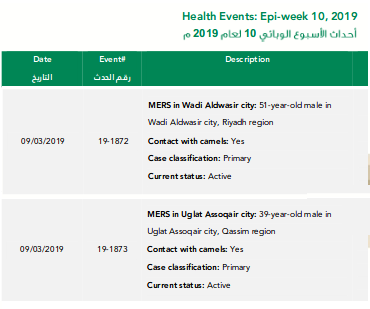
#13,921
Saudi Arabia's winter MERS surge continues with the announcement of their 96th and 97th infection for 2019. The number of cases reported over the past 10 weeks from Saudi Arabia now equals that nation's total for the last 10 months of 2018.
Today's two cases are listed as male (ages 51 & 39), and both as primary cases with recent camel contact. One is from Uglat Asugour City, about 300 miles Northwest of Riyadh, and the other from hard-hit Wadi Aldwasir 500 miles to the south of the Capital city.
While we tend to report case counts as `fact', one of the realities of disease surveillance is that the number of cases `officially' reported by public health agencies is assumed to only represent some fraction of the total number of cases in the community.
 |
| Credit CDC |
Factors affecting under-counts can include the percentage of mild cases (unlikely to be tested), the availability and quality of local medical care, the sensitivity of lab tests, the amount of background noise from similar diseases, and whether public health is actively `looking' for a specific disease.
In 2016's EID Journal: Estimation of Severe MERS Cases in the Middle East, 2012–2016, researchers estimated the true number of severe cases was 2.3-times higher than the total number of all of the laboratory-confirmed cases combined (including mild and asymptomatic) cases in the region.An earlier study in The Lancet came up with an even higher multiplier (see Transmission Estimates Of MERS-CoV – Lancet Infectious Disease),
suggesting that for every case identified, there are likely 5 to 10 that go undetected.
In truth, nobody knows how many MERS cases have occurred in Saudi Arabia, or across the Middle East, in 2019.What we can say is - assuming there have been no major changes in the way the Saudis are testing cases - the rate of infections appears to be running higher this winter than what we've seen in the past couple of years.
Despite these elevated numbers, community transmission of the MERS virus seems to remain sporadic and limited, meaning the virus has fallen short of producing a sustained epidemic. Hopefully that will remain the case.
But a 2017 study found the virus's basic reproduction number (R0 : pronounced R-nought) was inching closer to the magic number of 1.0, which is what is required for an outbreak to have `legs' (see A Pandemic Risk Assessment Of MERS-CoV In Saudi Arabia).So we continue to watch events in Saudi Arabia and the Middle East very closely, looking for any signs that the virus is becoming more of a threat.

